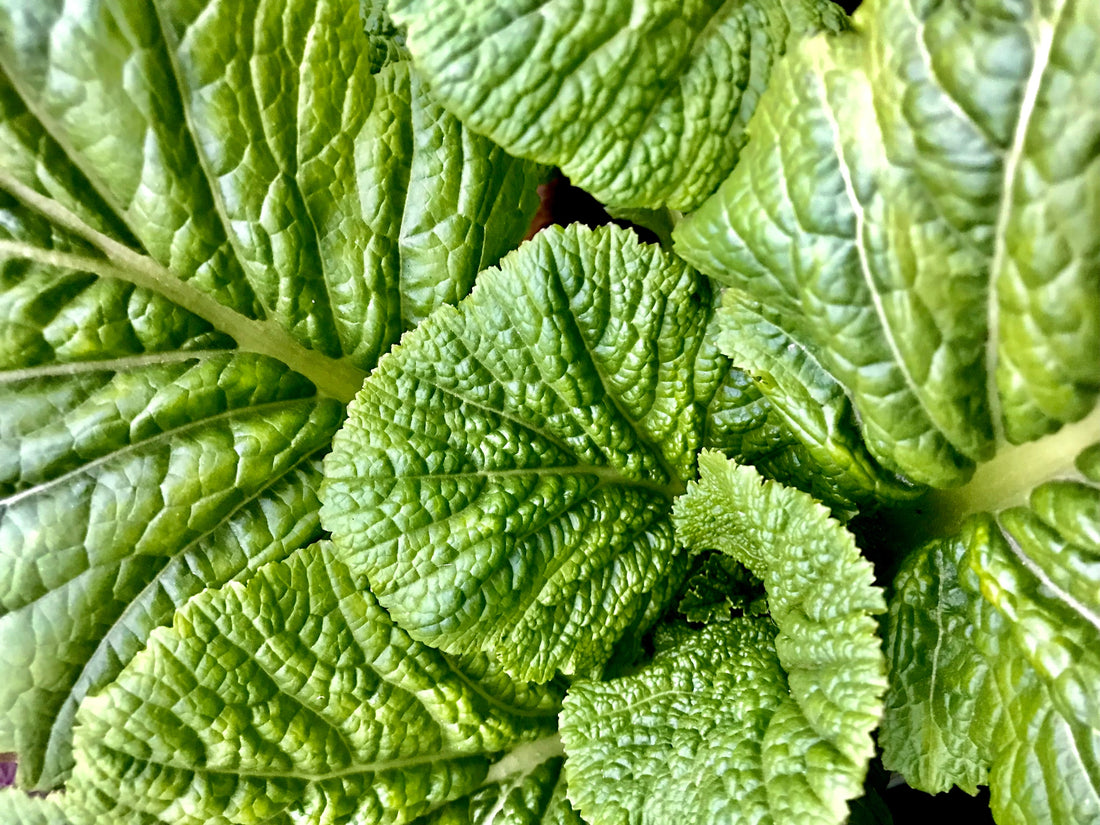Mustard is a leaf crop that comes in a variety of leaf types, colors, and textures. It can be used like spinach, cooked or incorporated into salads to add flavor and variety. Mustard greens do best in cool weather and should be planted so it can mature when temperatures are consistently below 80 degrees. There are three different types of mustard greens that are most commonly used: curly leafed, flat leafed, and tendergreen mustard. Mustard is easy to grow, and matures in a short 45-60 days.
SOIL PREPARATION
Mustard prefer a sandy soil, rich in organic matter, well drained, and not too heavy. They also need full sun exposure. Before planting, incorporate 1-2 inches of well composted organic matter, Humic, and 1 lb. of all-purpose fertilizer (we recommend “That’s all it Takes” complete fertilizer or Happy Frog Organic Tomato & Vegetable Food) per 100 square feet and work them in to a depth of 4-6 inches. Heavy, clay-based soils must be amended with compost and organic matter to encourage and allow for good root development. For best results, add 2-4 inches of a variety of different types of organic matter and 50 lbs. of Zeolite soil conditioner per 100 square feet each fall for multiple years to increase drainage and nutrient availability. By doing this yearly, over time you can create a better growing environment for your garden plants to thrive in and produce. Please consult our Soil Preparation Guide in the attached appendix.
PLANTING
Mustard is almost always grown from seed because of its quick germination, and can be sown directly outside anytime after the soil temperatures reach 40 degrees. Optimal seed germination is at 50- 70 degrees, so the best time to plant in Cache Valley is in March through early May, and again in August and September for a fall crop. Plant seeds about 1/4-1/2 inch deep and cover with a light mulch, Coconut Coir or potting soil to prevent soil crusting and to help retain moisture. Try to maintain uniform soil moisture for 7-10 days or until the seeds begin to emerge. As the seedlings begin to grow, thin the plants out to 1-2 inches apart in the rows, and 12-18 inches between rows.
VARIETIES
We carry Mizuna Mustard (curly leafed), Florida Broadleaf (flat), and Deep Purple (tendergreen). All these varieties have excellent flavor and some heat tolerance. Most mustard varieties grow quickly and early as microgreens, and taste amazing too!
WATER
Mustard needs regular water and consistent soil moisture to produce well. Use of a soaker hose and light mulches can assist in maintaining correct soil moisture and guaranteeing a healthy harvest. We recommend about 1-2 inches of water applied per week in 2-3 applications. Water fluctuations will yield tough and bitter leaves.
FERTILIZER
About 4 weeks after germination, apply a balanced vegetable food (“That’s All it Takes” or Happy Frog Organic Tomato & Vegetable Food) down the side of the row of plants and water thoroughly. 1-2 cups per 10 feet of row works well. For more leafy greens, use a higher nitrogen fertilizer like 21-0-0. We recommend the Tomato & Vegetable Food because it contains many micro-nutrients (like Boron & Iron) that prevent common problems in developing vegetables.
We also recommend treating your mustard seed or plants with beneficial microbes and mycorrhizae (Kangaroots or Myke). These added helpers bring nutrients and water directly to the plants that host them, making them stronger, more resistant to insects and diseases, and more drought tolerant.
COMMON PROBLEMS
Mustard doesn’t compete well with weeds and therefore weed control is vital to their success. Hand weed when necessary, and use pre-emergent weed controls (Treflan or Corn Gluten) after germination to prevent new weed emergence. Flea beetles, cabbage loopers and leaf miners commonly attack mustard and leave distinctive damage behind that can alert the observant gardener to their presence. Several safe and effective chemical and organic controls are available to stop these pests before they start - Ferti-lome Spinosad spray is an excellent organic choice, and Hi-Yield Indoor/Outdoor Insecticide works quickly and safely to stop a wide variety of insects.
HARVESTING
Mustard should be harvested when leaves reach full size and before the seed stalk forms. Strip the outer old leaves off first to continue to let new inner leafs to grow. Rinse and pat leaves dry and store in the fridge for up to 1-2 weeks.


1 comment
Thank you for teaching me on how to grow mustard greens. I founded an organization to help children, young people and women defeat hunger, illiteracy, and poverty worldwide. To help a child focus, we must feed them right. I appreciate what you are doing to feed the world. Please let me know what else I can learn from you. Thank you.